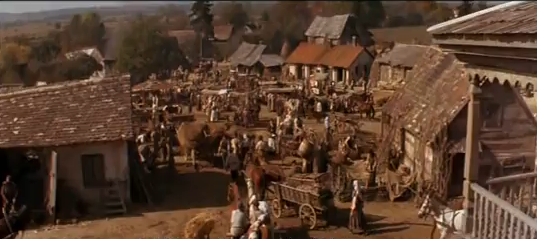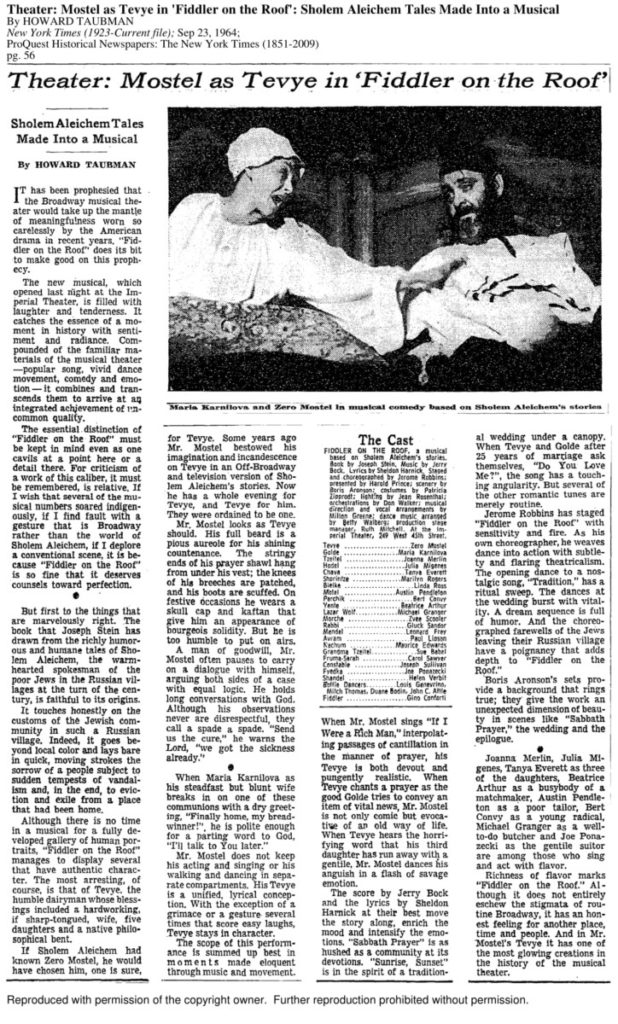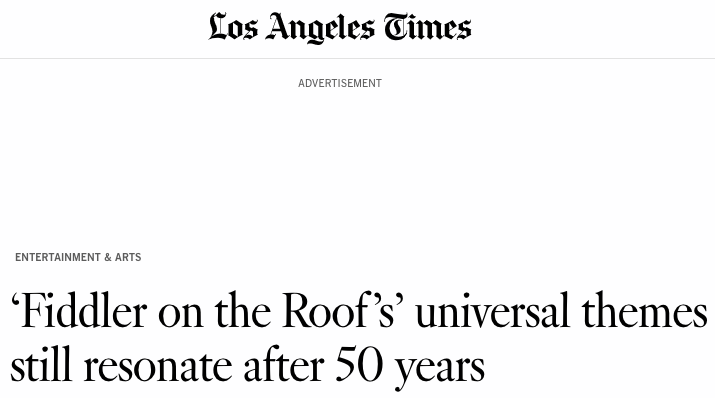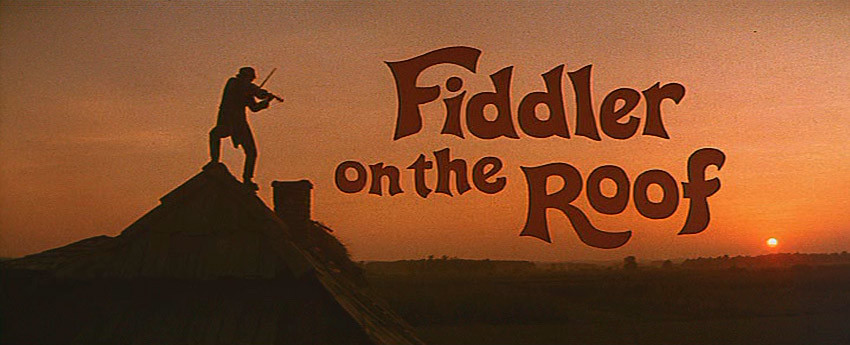Ben Levitt, HIST 385-8
Curator’s Introduction
Since its Broadway debut in 1964, Fiddler on the Roof has been a pillar of American Jewish culture and a worldwide phenomenon. When its original run ended in 1972, it became the longest running Broadway musical at the time with 3,242 performances. Since then, it has been revived numerous times and performed in 16 languages and 32 countries. Upon initial consideration, the enormous popularity of Fiddler on the Roof seems surprising due to its lack of obvious appeal beyond a Jewish audience. Inspired by the stories of the famous Yiddish author, Sholom Aleichim, Fiddler on the Roof is a nostalgic narrative of pre-Holocaust life for Jews living in an Eastern European shtetl. While the global success of Fiddler on the Roof warrants scholarly consideration, this exhibit will primarily focus on the original 1964 Broadway run as well as Norman Jewison’s 1971 film adaptation. In this exhibit, I will explore several questions about this important cultural product and its unlikely success: how did Fiddler on the Roof gain widespread appeal to non-Jewish audiences? Why was it popularized at this specific historical moment? What does Fiddler’s success imply about the American Jewish experience? My exploration of these questions will be guided by five objects that reflect the diverse ways of experiencing and understanding the historical moment of Fiddler on the Roof‘s initial success.
Through an analysis of the town of Anatevka, I will highlight the role of Fiddler on the Roof in exploring an ethnic group secure in their own identity, and the ways in which this was particularly relevant during a period that demanded assimilation and conformity to American norms. My analysis of the song “Tradition” will interpret the song in dialogue with a period of enormous American cultural upheaval. Through an analysis of the protagonist, Tevye, I will discuss his universal appeal and the ways in which he shapes depictions of observant Jews in American popular culture. My discussion of the final scene in the musical and the movie focuses on the ways in which it is a manifestation of both the successful Jewish experience in post-war America as well as the trauma of the Holocaust. Using excerpts from a Los Angeles Times article, I will offer insight into the universal appeal of this distinctly Jewish musical/film as well as a “double coding” effort by the producers to appeal both to a Jewish and non-Jewish audience.
Read together, these five objects offer an extensive although not comprehensive analysis of Fiddler on the Roof during its initial Broadway run and following the film release in 1971. It is my goal that this exhibit offers a new lens into this Jewish cultural artifact and the diverse ways in which it has shaped and been shaped by American and global culture.
Object 1: The Town of Anatevka

- Fiddler brought ethnicity to the forefront through the setting of Anatevka. It created a distinctly un-American Jewish world on stage without including any cultural bridge characters for the American theatre and movie audiences [8]. Flower Drum Song, released in a similar time period, had a very different message about ethnicity, identity and assimilation. Whereas Anatevka presents the security of Jewish identity and tradition, Flower Drum Song is the story of assimilation into America by shedding part of their Chinese identity and tradition.
- This is a watershed cultural object because it was the first musical to feature a group secure in their own ethnicity and identity. The thriving Jewish life in Anatevka helps reverse the assumption that ethnic erosion is a necessary price to achieve success. The Anatevka Jewish community is, in essence, an affirmation of the legitimacy of a conspicuous ethnic identity at a time during the post-WWII period when American society is demanding assimilation to an American nuclear family structure and conformity to American societal and cultural norms [8].
- Fiddler on the Roof was a trailblazer that charted the course for future musicals to enter into the “community, culture and values of that seemingly foreign world of the ‘other'”[8] whether that be an ethnic group or another seemingly foreign community with a shared identity
- For example, Hair, Rent, In the Heights and The Color Purple (musical) were all inspired by Fiddler on the Roof according to Hecht [8].
Object 2: Song, “Tradition”
(Tevye)
“Because of our traditions, we’ve kept our balance for many, many years.
Here in Anatevka we have traditions for everything…
how to eat, how to sleep, even, how to wear clothes.
For instance, we always keep our heads covered and always wear a little prayer shawl…
This shows our constant devotion to God. You may ask, how did this tradition start?
I’ll tell you – I don’t know. But it’s a tradition…
Because of our traditions, everyone knows who he is and what God expects him to do.”
(Tevye & Papas)
Who day and night
Must scramble for a living
Feed the wife and children
Say his daily prayers
And who has the right
As master of the house
To have the final word at home?
(All)
The papa, the papas… tradition
(Golde & Mamas)
Who must know the way to make a proper home?
A quiet home, a kosher home
Who must raise a family and run the home
So papa’s free to read the holy book?
(All)
The mama, the mama… tradition
(Sons)
At three I started Hebrew school
At ten I learned a trade
I hear they picked a bride for me
I hope… she’s pretty
(All)
The sons, the sons… tradition
(Daughters)
And who does mama teach
To mend and tend and fix
Preparing me to marry
Whoever papa picks?
(All)
The daughters, the daughters… tradition
….
(Tevye)
“Tradition. Without our traditions, our lives would be as shaky as… as a fiddler on the roof!”
Lyrics of “Tradition” from Fiddler on the Roof (Original Motion Picture Soundtrack), 1971.
- This song suggests that while tradition is integral to the Jewish society that exists in Anatevka, it is simultaneously being challenged (both internally and externally) in a rapidly changing world [8].
- How does the popularity of this song make sense in this period of American cultural history? 1964 (opening year of the musical) is a time of upheaval and change in America: Civil Rights Movement, Post-War Youth Culture [3].
- By 1971 (movie release), there are many elements of social change rapidly taking form in the United States:
- Post-war youth culture: a new generation rebelling against the norms and the will of the older generation (reflected by Tevye’s daughters in Fiddler)
- Civil Rights Movement
- Second-Wave Feminism and Betty Friedan’s The Feminine Mystique: a new desire to expand female agency, and particularly the role of the women outside of the home (also reflected by Tevye’s daughters) [5].
- The Gay Liberation Movement
Object 3: Tevye as a Character

“If Sholem Aleichem had known Zero Mostel, he would have chosen him, one is sure, for Tevye.”
- In Sholem Aleichem’s story, Tevye is a tragic figure clinging to Jewish tradition in a changing Russia. In Fiddler on the Roof, Tevye is recast according to a contemporary ideology. The new Tevye is a transitional figure who foreshadows the process of Americanization for Jews in the 20th century. Each actor who plays Tevye recasts Jewish cultural history based on the contemporary societal context [9]. Zero Mostel was the first actor to play Tevye. As is articulated in this primary source, a review of Fiddler on the Roof from 1964, Zero Mostel defined Tevye as a character and how Tevye was perceived by the audience [1].
- In his article, Seth Wolitz explains: “Each Tevye recasts Jewish cultural history according to a contemporary ideology… The [1964] musical Tevye becomes a Jewish pilgrim, a victim of religious persecution, fleeing intolerant Europe to the land of fulfillment, America… Tevye becomes an almost progressive grandfather figure, a legitimizer of change.” [9]
- Tevye is “the personification of the Jewish immigrant and the universal grandfather of Jewish America” [1]. He is a widely popular figure who was, at the time, the most successful example of a Jewish character attaining “crossover success” across borders, cultures and ethnicities. As Norman Nadel stated in his review of Fiddler: “You don’t have to be Jewish to love Tevye” [1].
- I’d argue that Tevye’s level of popular recognition is rivalled only by Jewish television characters in the 1980s and 1990s: Jerry Seinfeld from Seinfeld, and Monica Geller and Ross Geller from Friends. Tevye is an anomaly, since he is the only of these characters who is strictly observant of traditional Jewish practices and visibly representative of religious Jewish stereotypes. Tevye is an example of what it means to act Jewish in popular culture, not simply identify with the Jewish culture/peoplehood, but rather to fully embrace traditional observant Judaism.
Object 4: Final Scene of the 1971 Film
- At the end of “Tevye the Milkman”, the original compilation of Sholem Aleichim stories on which Fiddler on the Roof is based, Tevye is expelled by the town constable when the village is officially declared a “no-Jew” zone. It is unclear where he goes, but it is intended to be a tragic ending that shows the peril of Jews in Eastern Europe.
- By contrast, at the end of the 1964 musical and 1971 movie, Tevye, Golda and their two youngest daughters leave Anatevka and move to America. The producers of Fiddler on the Roof chose to modify the ending to present a migration from the suffering of the ‘Old World’ to the freedom and opportunity of America (the ‘New World’). For many Jewish audience members, the ending of Fiddler on the Roof is an affirmation of the Jewish-American mythos of adaptability, and Tevye is the personification of the Jewish immigrant [1].
- The ending is integral to the historical context of Fiddler on the Roof. Much of Fiddler’s Jewish audience were second generation Americans who had been born and raised in America and were largely assimilated to American society. A large part of the mythic narrative of American Jewry was focused on success, prosperity and integration: in the post-WWII period, Jews were rapidly gaining new opportunities in American society (i.e. Jewish participation in suburbanization). It was this feeling of security in American life that allowed a Jewish audience in the 1960s and 1970s to indulge in the roots of the Old World while simultaneously portraying a grim future on the horizon. This retelling of late 19th/early 20th century Eastern European Jewish history is also informed by American Jews’ attempt to grapple with the raw emotion and tragedy of the Holocaust. The ending to Fiddler on the Roof, in which the protagonists immigrate to America in search of a better life, is both an articulation of the largely successful Jewish experience in America as well as an attempt to process the horrors of the Holocaust [3].
Object 5: Los Angeles Times Article, August 30, 2014, Barbara Isenberg


“Until ‘Fiddler,’ musicals spoke only to the immediate generation. ‘Fiddler’ showed how a musical could speak to all generations and cultures.”

“It’s about tradition… That’s it.”

Explanation of Fiddler’s success in countries like Japan. It’s not just a Jewish story. Rather, there are “strong themes of tradition, repression, prejudice and diaspora [that] evoke common ground for audiences” regardless of nationality.
- Fiddler on the Roof is a clear example of what Henry Bial calls “double coding”. “Double coding” is the simultaneous construction of different meanings and messages to appeal to different audiences. Fiddler on the Roof maintains its distinctly Jewish character (including many Jewish references), while also universalizing its core messages about the relationships between tradition (symbolized by Tevye and the town of Anatevka) and rapid change of the present (symbolized by Tevye’s daughters) [3], as well as other ideas about love, diaspora, generational clash and prejudice. This duality of specificity and universalization is underscored in Barbara Isenberg’s article, which outlines the ongoing success of Fiddler on the Roof based on its appeal to both Jewish and non-Jewish audiences [4]. This helps explain the global success of Fiddler on the Roof, especially in countries without a substantial Jewish population such as the highly successful production in Japan. The relevance of Fiddler on the Roof is tied to its ability to universalize its core messages.
- Sometimes, the pursuit of universal appeal comes at the expense of certain elements of ‘authenticity’. For example, most Yiddish was removed from the musical and film unless it was part of the American vernacular [3].
Works Cited:
[1] Bial, Henry. “Acting Jewish: Negotiating Ethnicity on the American Stage & Screen.” 59–85. Ann Arbor: University of Michigan Press, 2005.
[2] Gilman, Sander L. “There Ain’t No There There: Reimagining Eastern European Jewish Culture in the 21st Century.” Shofar: An Interdisciplinary Journal of Jewish Studies 25, no. 1 (2006): 1–4.
[3] Hillman-McCord, Jessica. “Echoes of the Holocaust on the American Musical Stage.” 66–89. Jefferson, N.C: McFarland, 2012.
[4] Isenberg, Barbara. “‘Fiddler on the Roof’s’ Universal Themes Still Resonate after 50 Years.” Los Angeles Times. Last modified August 30, 2014. Accessed Dec. 3, 2019. https://www.latimes.com/entertainment/arts/la-et-cm-ca-tradition-fiddler-on-the-roof-20140831-story.html.
[5] Isenberg, Barbara. Tradition! The Highly Improbable, Ultimately Triumphant Broadway-to-Hollywood Story of Fiddler on the Roof, the World’s Most Beloved Musical. New York: St. Martin’s Press, 2014.
[6] Solomon, Alisa. “Balancing Act: Fiddler ’s Bottle Dance and the Transformation of ‘Tradition.’” TDR/The Drama Review 55, no. 3 (Sept. 2011): 21–30.
[7] Solomon, Alisa. Wonder of Wonders: A Cultural History of Fiddler on the Roof. First edition. New York: Metropolitan Books, 2013.
[8] Hecht, Stuart J. “Transposing Broadway: Jews, Assimilation, and the American Musical.” 179–200. Palgrave Macmillan, New York, US, 2011.
[9] Wolitz, Seth L. “The Americanization of Tevye or Boarding the Jewish ‘Mayflower.’” American Quarterly 40, no. 4 (Dec. 1988): 514–536.
